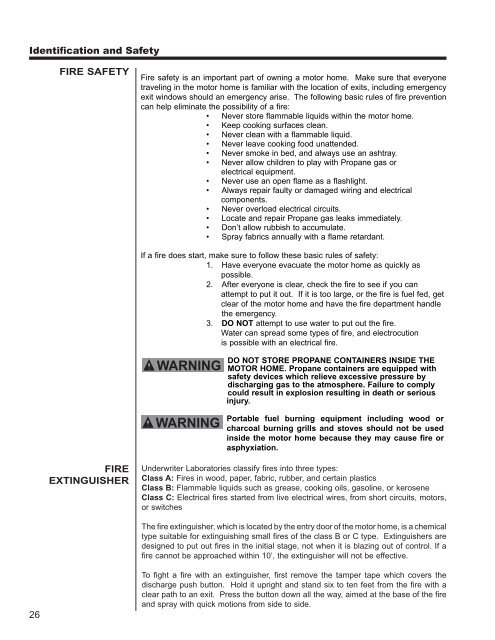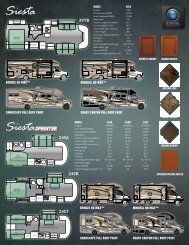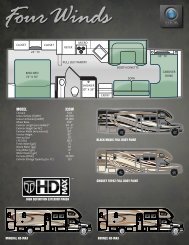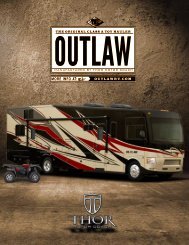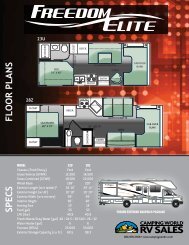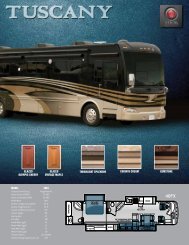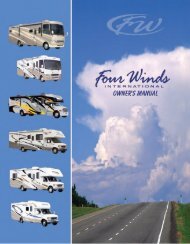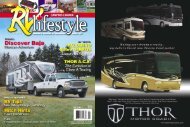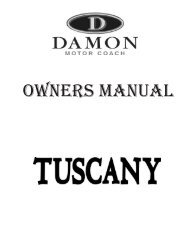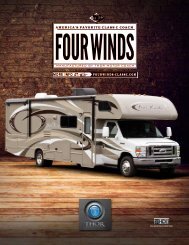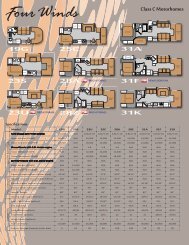caution - Thor Motor Coach
caution - Thor Motor Coach
caution - Thor Motor Coach
You also want an ePaper? Increase the reach of your titles
YUMPU automatically turns print PDFs into web optimized ePapers that Google loves.
Identification and Safety<br />
26<br />
FIRE SAFETY<br />
FIRE<br />
EXTINGUISHER<br />
Fire safety is an important part of owning a motor home. Make sure that everyone<br />
traveling in the motor home is familiar with the location of exits, including emergency<br />
exit windows should an emergency arise. The following basic rules of fire prevention<br />
can help eliminate the possibility of a fire:<br />
• Never store flammable liquids within the motor home.<br />
• Keep cooking surfaces clean.<br />
• Never clean with a flammable liquid.<br />
• Never leave cooking food unattended.<br />
• Never smoke in bed, and always use an ashtray.<br />
• Never allow children to play with Propane gas or<br />
electrical equipment.<br />
• Never use an open flame as a flashlight.<br />
• Always repair faulty or damaged wiring and electrical<br />
components.<br />
• Never overload electrical circuits.<br />
• Locate and repair Propane gas leaks immediately.<br />
• Don’t allow rubbish to accumulate.<br />
• Spray fabrics annually with a flame retardant.<br />
If a fire does start, make sure to follow these basic rules of safety:<br />
1. Have everyone evacuate the motor home as quickly as<br />
possible.<br />
2. After everyone is clear, check the fire to see if you can<br />
attempt to put it out. If it is too large, or the fire is fuel fed, get<br />
clear of the motor home and have the fire department handle<br />
the emergency.<br />
3. DO NOT attempt to use water to put out the fire.<br />
Water can spread some types of fire, and electrocution<br />
is possible with an electrical fire.<br />
DO NOT STORE PROPANE CONTAINERS INSIDE THE<br />
MOTOR HOME. Propane containers are equipped with<br />
safety devices which relieve excessive pressure by<br />
discharging gas to the atmosphere. Failure to comply<br />
could result in explosion resulting in death or serious<br />
injury.<br />
Portable fuel burning equipment including wood or<br />
charcoal burning grills and stoves should not be used<br />
inside the motor home because they may cause fire or<br />
asphyxiation.<br />
Underwriter Laboratories classify fires into three types:<br />
Class A: Fires in wood, paper, fabric, rubber, and certain plastics<br />
Class B: Flammable liquids such as grease, cooking oils, gasoline, or kerosene<br />
Class C: Electrical fires started from live electrical wires, from short circuits, motors,<br />
or switches<br />
The fire extinguisher, which is located by the entry door of the motor home, is a chemical<br />
type suitable for extinguishing small fires of the class B or C type. Extinguishers are<br />
designed to put out fires in the initial stage, not when it is blazing out of control. If a<br />
fire cannot be approached within 10’, the extinguisher will not be effective.<br />
To fight a fire with an extinguisher, first remove the tamper tape which covers the<br />
discharge push button. Hold it upright and stand six to ten feet from the fire with a<br />
clear path to an exit. Press the button down all the way, aimed at the base of the fire<br />
and spray with quick motions from side to side.


